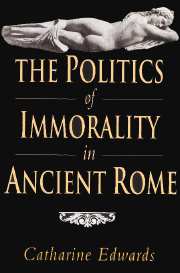Book contents
- Frontmatter
- Contents
- Preface
- Introduction
- 1 A moral revolution? The law against adultery
- 2 Mollitia: reading the body
- 3 Playing Romans: representations of actors and the theatre
- 4 Structures of immorality: rhetoric, building and social hierarchy
- 5 Prodigal Pleasures
- Bibliography
- Index locorum
- Index of subjects and proper names
4 - Structures of immorality: rhetoric, building and social hierarchy
Published online by Cambridge University Press: 23 September 2009
- Frontmatter
- Contents
- Preface
- Introduction
- 1 A moral revolution? The law against adultery
- 2 Mollitia: reading the body
- 3 Playing Romans: representations of actors and the theatre
- 4 Structures of immorality: rhetoric, building and social hierarchy
- 5 Prodigal Pleasures
- Bibliography
- Index locorum
- Index of subjects and proper names
Summary
The rhetoric of Roman moralising has often seemed alien to modern readers. This book, in linking together studies of apparently diverse topics, might be seen as appropriating a trope of Roman moralistic discourse, presenting arguments concerning different subjects as parallel so that they may serve to reinforce one another. A better understanding of this and similar literary devices, as they operate in Roman moralising texts, can help us to make sense of some features of those texts which modern readers have found puzzling. Let us begin with an apparently bizarre example of this kind of rhetoric (included in the book of rhetorical exercises put together by the elder Seneca):
quin etiam montes silvasque in domibus marcidis et in umbra fumoque viridia aut maria amnesque imitantur. vix possum credere quemquam eorum vidisse silvas, virentisque gramine campos … quis enim tam pravis oblectare animum imitamentis possit si vera cognoverit? … ex hoc litoribus quoque moles iniungunt congestisque in alto terris exaggerant sinus; alii fossis inducunt mare: adeo nullis gaudere veris sciunt, sed adversum naturam alieno loco aut terra aut mare mentita aegris oblectamenta sunt. et miraris <si> fastidio rerum naturae laborantibus iam ne liberi quidem nisi alieni placent?
Men even imitate mountains and woods in their foul houses – green fields, seas and rivers amid the smoky darkness. […]
Information
- Type
- Chapter
- Information
- The Politics of Immorality in Ancient Rome , pp. 137 - 172Publisher: Cambridge University PressPrint publication year: 1993
Accessibility standard: Unknown
Why this information is here
This section outlines the accessibility features of this content - including support for screen readers, full keyboard navigation and high-contrast display options. This may not be relevant for you.Accessibility Information
- 3
- Cited by
